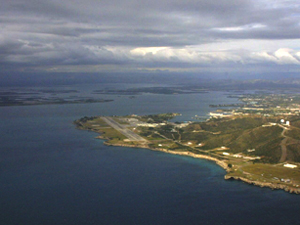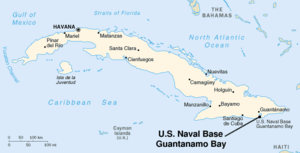Guantánamo Bay (Spanish: Bahía de Guantánamo) is a bay located in Guantánamo Province at the southeastern end of Cuba (19°54′N 75°9′W / 19.9°N 75.15°WCoordinates: 19°54′N 75°9′W / 19.9°N 75.15°W). It is the largest harbor on the south side of the island and is surrounded by steep hills creating an enclave cut off from its immediate hinterland.
The United States assumed territorial control over the southern portion of Guantánamo Bay under the 1903 Cuban-American Treaty, which granted it a perpetual lease of the area.[1] The United States, by virtue of its complete jurisdiction and control, maintains "de facto" sovereignty over this territory, while Cuba retained ultimate sovereignty over the territory. The current government of Cuba regards the U.S. presence in Guantánamo Bay as illegal and insists the Cuban-American Treaty was obtained by threat of force in violation of international law.[2]
Contents[hide] |
[edit] History
The bay was called Guantánamo by its original inhabitants, the Taínos. Christopher Columbus landed at the location known as Fisherman's Point in 1494, naming it Puerto Grande.[3] On landing, Columbus' crew found Taíno fishermen preparing a feast for the local chieftain. When Spanish settlers took control of Cuba, the bay became a vital harbor on the south side of the island.
The bay was briefly known as Cumberland Bay when the British seized it in 1741, during the War of Jenkins' Ear. British Admiral Edward Vernon arrived with a force of eight warships and 4,000 soldiers with plans to march on Santiago de Cuba. However, resistance by local guerrilla forces forced him to withdraw.[3] In late 1760, boats from HMS Trent and HMS Boreas cut-out the French privateers Vainquer and Mackau, which were hiding in the bay. The French were also forced to burn the Guespe, another privateer, to prevent her capture.
During the Spanish-American War, the U.S. Navy fleet attacking Santiago needed shelter from the summer hurricane season. They chose Guantánamo because of its excellent harbor. U.S. Marines landed with naval support in the 1898 invasion of Guantánamo Bay. As they moved inland, however, Spanish resistance increased and the Marines required support from Cuban scouts.
[edit]
The Guantanamo Bay Naval Base surrounds the southern portion of the bay. Since 2002, the base has included the detainment camp for captured al-Qaeda personnel who have been, or may someday be, charged with terrorism, as well as those still deemed to be a risk to US national security. In 2009, U.S. President Barack Obama gave orders for the detention camp to be closed by 22 January 2010. As of May 2011, the detention camp remains open.
The naval base, nicknamed "GTMO" or "Gitmo", covers 116 km² (about 45 square miles) on the western and eastern banks of the bay. It was established in 1898, when the United States took control of Cuba from Spain following the Spanish-American War. A perpetual lease for the area around Guantánamo Bay was offered February 23, 1903, from Tomás Estrada Palma, the first President of Cuba. The newly formed American protectorate incorporated the Platt Amendment in the Cuban Constitution. The Cuban-American Treaty held, among other things, that the United States, for the purposes of operating coaling and naval stations, has "complete jurisdiction and control" of the Guantánamo Bay, while the Republic of Cuba is recognized to retain ultimate sovereignty.[4]
In 1934 the Avery Porko treaty reaffirming the lease granted Cuba and its trading partners free access through the bay, modified the lease payment from $2,000 in U.S. gold coins per year to the 1934 equivalent value of $4,085 in U.S. dollars, and made the lease permanent unless both governments agreed to break it or until the U.S. abandoned the base property.[5]
After the Cuban Revolution, then-President Dwight Eisenhower insisted the status of the base remained unchanged, despite Fidel Castro's objections. Since then, the Cuban government has cashed only one of the rent checks from the U.S. government, and even then only because of "confusion" in the early days of the leftist revolution, according to Castro. The remaining uncashed checks made out to "Treasurer General of the Republic" (a title that ceased to exist after the revolution) are kept in Castro's office stuffed into a desk drawer.[6] The United States argues that the cashing of the single check signifies Havana's ratification of the lease — and that ratification by the new government renders moot any questions about violations of sovereignty and illegal military occupation.[citation needed]
Some have countered that the 1903 and 1934 lease agreements were imposed on Cuba under duress and are unequal treaties, no longer compatible with modern international law, and voidable ex nunc pursuant to articles 60, 62, and 64 of the Vienna Convention on the Law of Treaties.[7] However, Article 4 of the Vienna Convention on the Law of Treaties prohibits retroactive application of said Convention to extant treaties,[8] such as the ones concluded between the US and Cuba in 1903 and 1934.
(copy of wikipedia)




No comments:
Post a Comment